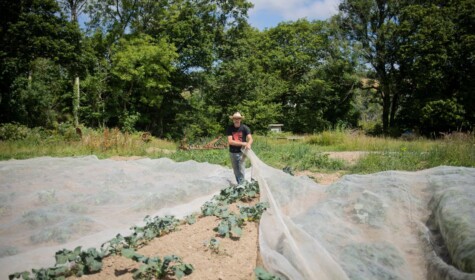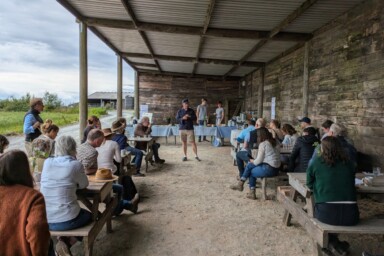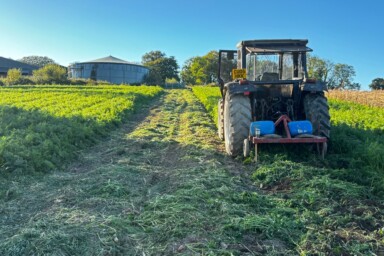It was heartening to read the report, Eat More Vegetables! Grow More Vegetables! But Who Will Grow the Vegetables?, recently published by the Food Research Collaboration at City University London, on the potentiality of expanding agroecological horticulture across Britain. Commercial UK horticulture has been struggling post-Brexit – starting with the misguided idea that young British workers would step into void once all the overseas workers had been banished, something the Government continues to believe. Large-scale conventional horticulture is a very different beast from small- and medium-scale agroecological horticulture (which has a distinct USP), and it carries little of the ethos of agroecological production methods – although this may change as the climate shifts and nitrogen fertiliser continues to increase in cost. However, scale matters and one of the distinct features, in particular, of smaller-scale agroecological production is a move away from long supply chains and supermarket contracts to localised production, direct sale and a circular economy. This is important in an increasingly destabilised world, where you might want to want to know more precisely where your food is coming from.
A growth in small scale growers
The Food Research Collaboration cites some exciting statistics in their report: both the Land Workers’ Alliance (LWA) and the Organic Growers Alliance (OGA) have seen significant growth in their membership – the LWA, an increase of 81% over the past three years and the OGA, a 72% increase over a similar period with CSA membership also expanding from 33 to 200 members. Most notably, also, the LWA’s members are young – just what we need in farming and growing – with 50% under the age of 40. So, there is much hope for a younger generation who feel a call to the land and are willing take on the hard work. This must be supported with mentoring from farmers and growers that have skills and expertise and more extensive training programmes, and there needs to be value and meaning for those who take it on. But further, to really realise this, there must be access to money – whether public sector funding or private sector financing – and, inevitably, land.
The role that small- and medium-scale horticulture can play in inspiring the next generation to put their life into growing food that is healthy, sustaining and spectacularly tasty, is critical. With two-thirds of UK adults overweight and obese, it is clear that what we eat is significantly out of whack with what we should eat. The statistics around fruit and vegetable consumption are pretty dreadful in the UK – the proportion of people eating less than a portion of fruit or veg a day is increasing with the 29% of 5 – 10 year olds also falling into this category; one in five kids are eating an exceptional amount of ultra-processed food (comprising 78% of their diet); and even if we could turn these stats around, we still don’t produce enough fresh fruit and veg for everyone to get their 5-a-day.
Getting people to eat better is one of our most fundamental challenges. With the arrival of increasingly processed foods in the developed world, from the 1970s onwards, healthy eating has taken a beating. People don’t eat well for a wide variety of reasons, with food poverty issues a significant one. It’s not just that fresh fruit and vegetables can be expensive – it’s also that people may not have a stove or oven, or if they do, the cost of running it is more than they can afford. A BBC survey in 2014 revealed that reasons that adults and young people don’t eat enough fruit and veg: these included its expense and not knowing how to incorporate fruit and veg into their diets; also, unsurprisingly, not really believing it was that important in their diets.
Better opportunities, better diets
So, what can we do to help people eat better? The answers are myriad, of course. However, the starting point could be in smaller-scale, environmentally sound horticulture operating on a local level. There are a wealth of opportunities here, both urban and rural, that could support both growers and eaters. To realise this, what is most needed is a wider network of producers – ideally young and well-supported by local government to engage with a diverse demographic range of communities. These could be networked with schools, universities and other learning opportunities to provide not just healthy local food, but also skills, experience and engagement with food production more broadly. Understanding that food comes from the land and making that connection with it, is essential in re-orienting diets.
There is a potential for a sea change here. One example that is blossoming in West Wales is Canolfan Tir Glas at the University of Wales Trinity St. David in Lampeter. This ambitious project includes a new academy that will focus on sustainable food systems ‘on a regional, national and global basis…[informing] the delivery of practical skills training across the food chain’. Here food education can interface with policy and public bodies, reaching out to local horticulture producers for knowledge and expertise, but also supporting what they do and acknowledging their value to the community as a whole. Simon Wright, who is heading up the Academy of Contemporary Food Wales, says that ‘The aim is to not only identify opportunities to bring a new impetus to skills and training but to use that intervention to significantly grow the sector and to bring together public bodies to create a policy context in terms of issues like procurement, planning and access to land in which that can happen.’
Such thinking offers a picture of what can be built in a food community and the role that agroecological localised food production can play in increasing access to healthy food for all, but also in helping that next generation of growers to thrive – because we need them more than ever.






